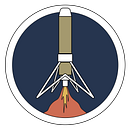Propulsive Landers @ Georgia Tech: Who We Are & What We Do
We are here for one goal and for one goal only — to become the first student team in the world to achieve hovering, vertical take off, and landing (VTOL) of a hybrid rocket.
This is Propulsive Landers @ Georgia Tech, welcome to our first monthly newsletter where we provide you with the newest updates. Except, for this one at least, it will be about who we are, and you guessed it — what we do.
Who We Are
Propulsive Landers is a student organization at Georgia Tech composed of 90 members. Within our team, we are divided into five sub teams: Propulsion, Avionics & Guidance, Navigation, and Control (A&GNC), Structures, Marketing, and Administration. Here, you can find all sorts of majors. We have people from Aerospace Engineering (AE) and Mechanical Engineering (ME) of course, but also people from Physics, Biomedical Engineering (BME), Nuclear Engineering (NE), and many others. Unique in our strengths, we’re united by a shared purpose.
That purpose — to achieve propulsive landing. Propulsive landing by definition, is a method of decelerating and controlling the descent of a vehicle using its own propulsion system to achieve a controlled and precise landing. That’s exactly what we do but with a couple of touches before we get to the actual rocket.
To hover a rocket is no easy task. You have tens of thousands of dollars flying mid-air, during which anything can go wrong: you can suddenly lose power, your engine could malfunction, and in the worst case scenario, you could lose stability over the entire rocket. Like Tom Muller, the 1st employee at Space X and now the CEO of Impulse Space, said, “Rockets are very complex, and every part of the rocket has to work perfectly for it to work at all.” That’s why we focus extensively on testing and validating each component of the rocket (especially our GNC algorithms) before we even consider flight at that scale.
Monoprop UAV
Our first project, with that being said, is the development of a Monoprop UAV. Imagine a quadcopter but instead of 4 rotating propellers placed in four corners, there is just one set of counter-rotating propellers at the bottom of the UAV. This introduces significant technical challenges to the entire system.
- Firstly, there is an increased control complexity as we lose control over roll, and only have access to control over yaw and pitch through our thrust vector control (TVC) module. In the perspective of control systems, that means we can no longer have direct 3 degrees of freedom.
- Secondly, stability is notably more difficult to achieve. With only a single set of propellers, any disturbance, such as wind, can cause potentially significant deviations in orientation. The Monoprop’s systems need to respond quickly and precisely to maintain stability in real time. This adds another layer of challenge as we need high responsive control systems and sensors to detect and correct even the slightest disturbances.
- Lastly, there is limited literature available on Monoprop UAVs. Unlike quadcopters or other multirotor systems that have extensive research, well-established control algorithms, and a wealth of case studies, this approach is relatively uncharted. The lack of readily available references means we must construct much of the knowledge through experimentation, trial, and error.
On the bright side, and one that we are particularly excited about, is that designing from a position with fewer proven solutions also requires us to innovate and think critically at every step. In this case, the Monoprop UAV allows us to experiment with real-time hovering, stability, and precise control mechanisms on a smaller, more manageable scale.
Reaction Control System (RCS)
Moving on from the Monoprop UAV, our second ongoing project is the development of a Reaction Control System (RCS), otherwise known as cold gas thrusters. Previously, we discussed the problem that onboard the Monoprop UAV/Rocket, we only have direct control over our yaw, and pitch. RCS solves exactly that. By having 2 pairs of RCS thrusters (2 in each roll direction) mounted parallel to the x-axis of the rocket, we now have control over roll. From the system’s perspective, our control systems now can utilize all three degrees of freedom to make more accurate and quicker responses.
In the coming months, we look forward to establishing ourselves as an official Registered Student Organization (RSO) and securing more funding to bring our projects to life. But for now, that’s all we have for you! Stay tuned in the coming months for updates on our progress, technical breakthroughs, and the milestones we achieve along the way.
The journey to VTOL with a hybrid rocket is undoubtedly a challenging one, but we are confident that we’ll make history together.
Propulsive Landers @ Georgia Tech
